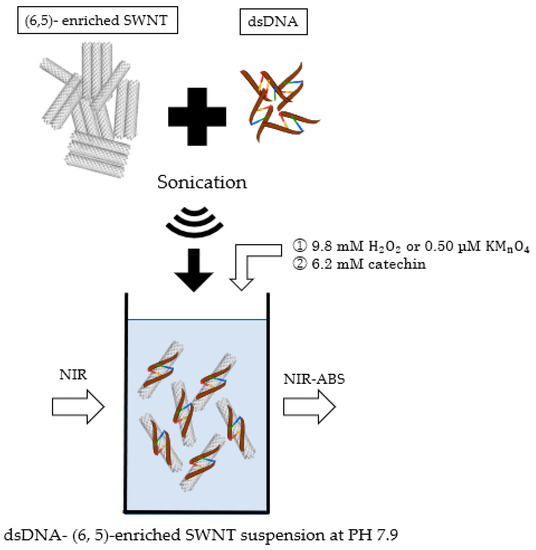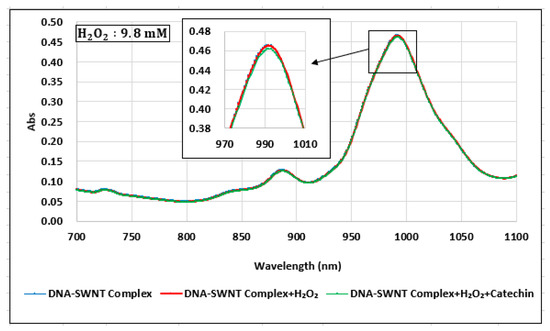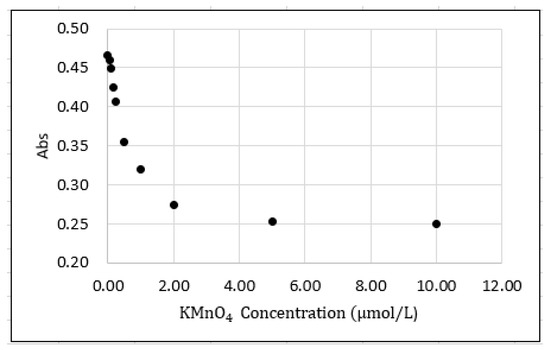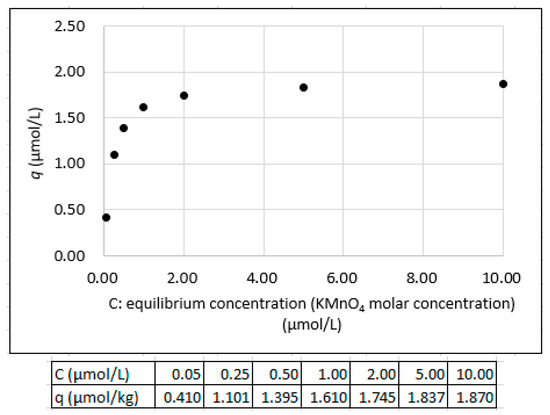Abstract
It has been reported that even if single-walled carbon nanotubes (SWNTs) are coated with the same polymer, the redox characteristics change of each chirality may differ. Particularly, the addition of hydrogen peroxide (H2O2) minimally affects the near-infrared (NIR) absorption spectra of the dsDNA-(6,5)-enriched SWNT complex (DNA-SWNT complex). Detecting the redox properties of (6,5) chirality using NIR absorption spectra has been one of the issues to be solved. We hypothesized that an oxidizing agent with high oxidizing power is required to detect the absorption spectra of (6,5) chirality. In this study, we used KMnO4, which contains atoms with a high oxidation number. A dispersion was prepared by mixing 0.5 mg of (6,5)-enriched SWNT powder with 1 mg/mL of DNA solution. After adding H2O2 or KMnO4 to this dispersion and oxidizing it, catechin solutions were added to reduce the dispersion. The absorption peak of the DNA-SWNT complex decreased by 23.9% following the addition of KMnO4 (final concentration: 0.5 µM) and recovered 30.7% following the addition of the catechin solution. We revealed that the changes in the absorption spectra change of (6,5) chirality, which could not be detected by H2O2, can be detected by using KMnO4. We also varied the concentration of KMnO4 and verified whether the adsorption of KMnO4 can be modeled as a Langmuir adsorption isotherm.
1. Introduction
Single-walled nanotubes (SWNTs) can be synthesized by using different methods. Common methods include the chemical vapor deposition (CVD) method, in which a carbon-based gas is blown into a heating furnace with a carrier gas to synthesize SWNTs [1,2,3,4]; the arc discharge method, in which DC or AC is applied to graphite electrodes to grow SWNTs [5,6]; and the laser evaporation method, in which graphite is used as a carbon source to facilitate heating and evaporation by laser irradiation and obtain SWNTs [7]. In a recent study, Haque et al. reported that CVD-synthesized multi-walled carbon nanotubes were converted to diamonds, without the addition of a catalyst, following application of a nanosecond pulsed laser melting process at ambient temperature and air pressure [8]. Additionally, Narayan et al. realized the epitaxial growth of diamond nanofibers by applying a nanosecond laser melting technique to supercooled carbon nanofibers and nanotubes, followed by rapid cooling [9].
The SWNTs produced as a result of employing these methods have a cylindrical one-dimensional structure rolled with graphene sheets, and have excellent electrical characteristics. SWNTs have optical characteristics that are strongly dependent on how the graphene sheet is wound, which can be represented by the chiral vector (n, m) [10,11,12,13,14]. It is very important to have a deep understanding of the electrical properties of each chirality from the fundamental and applied perspectives of carbon nanotubes. To date, many studies on redox characteristics focusing on the optical response of carbon nanotubes have been reported [15,16,17,18,19]. However, because the optical response of (6,5) chirality to H2O2 is weak, detecting the redox properties in the near-infrared (NIR) absorption spectra is one of the issues to be solved.
Polo et al. investigated the effects of reducing and oxidizing small molecules on the NIR fluorescence of polymer-wrapped SWNTs. They reported that the (6,5) chirality of SWNTs decreased by 81% from the initial state as a result of adding the oxidizing agent riboflavin; it also increased by 141% from the initial state as a result of adding the reducing agent ascorbic acid. They found that the fluorescence of reductive molecules of compounds such as ascorbic acid, epinephrine, and Trolox only significantly increases when SWNTs are suspended in a negatively charged polymer such as DNA or polyacrylic acid [20,21]. However, their study focused on the photoluminescence (PL) intensity of SWNTs, and did not include an investigation into the characteristics of the absorption spectra.
Zheng et al. found that electron transfer occurs readily between small molecule redox reagents and semiconducting carbon nanotubes. Furthermore, a direct correlation between the bandgap of semiconductor nanotubes and their reduction potential was identified. In their study, they showed that (6,5)-enriched SWNTs can be easily oxidized by adding potassium (IV) chloroiridate (K2IrCl6) as an oxidant; they found that changes in concentration affected the absorption spectra [22]. However, they did not report on the KMnO4-induced redox action of SWNTs.
Our group has previously investigated the (9,4) and (8,7) chirality of SWNTs; we consequently determined the redox characteristics of SWNTs by applying NIR and PL in order to reveal the optical response of SWNTs to H2O2 and catechin [23,24]. In these papers, we reported that it was difficult to determine the extent of oxidation because the optical response was weak, even when H2O2 was added to the DNA-(6,5)-enriched SWNT complex coated with DNA.
In this study, we focused on the oxidation numbers of the atoms contained in the oxidizing agent and compared the oxidation numbers of the atoms contained in H2O2 and KMnO4. The oxidation number of the oxygen (O2) in H2O2 is −1, and the oxidation number of the manganese (Mn) in KMnO4 is +7. The difference is clear; therefore, we used KMnO4, which contains atoms with a high oxidation number. KMnO4 (oxidant) and catechin (reductant) solutions were sequentially added to the DNA-SWNT complex, and the NIR and PL spectra were measured. The results revealed a clear optical response that can be attributed to redox of the (6,5) chirality. Additionally, we show that the oxidation state of the (6,5) chirality can be determined by using KMnO4 and analyzing the absorption spectra.
2. Materials and Methods
For this study, (6,5)-enriched SWNT powder (No. 773735-250G), which was manufactured by using CoMoCAT synthesis method, and dsDNA (deoxyribonucleic acid sodium salt from salmon testes, D1626) were purchased from Sigma-Aldrich Co., LLC (St. Louis, MO, USA). Hydrogen peroxide (abt. 30%, 084-07441) and catechin (553-74471) were purchased from Wako Pure Chemical Industries, Ltd. (Osaka City, Osaka, Japan). Potassium permanganate solution (No. 42000375) was obtained from Hayashi Pure Chemical Ind., Ltd. (Osaka City, Osaka, Japan).
A 1 mg/mL dsDNA solution was prepared with a 10 mM tris(hydroxymethyl)aminomethane- HCl (Tris-HCL) buffer (pH 7.9). To untangle the dsDNA molecules, the solution was sonicated, on ice, in a bath-type ultrasonicator (80 W) for 90 min. Finally, the dsDNA solution was gently shaken for 3 h. To prepare the dsDNA-(6,5)-enriched SWNT complex, 0.5 mg of SWNT powder and 1 mL of the dsDNA stock solution were mixed and sonicated on ice for 1.5 h using a probe-type sonicator (3W, VCX130, Sonic & Materials, Inc., Newtown, CT, USA). The supernatant of the prepared dsDNA-(6,5)-enriched SWNT dispersion was stored after undergoing 17,360 g centrifugation at a temperature of 8 °C for a period of 3 h [25,26,27].
A UV–vis spectrophotometer (V-630, JASCO Corp., Hachioji City, Tokyo, Japan) was employed for NIR measurements. NIR measurement entailed mixing the DNA-SWNT complex and 440 μL of Tris-HCL buffer in a cuvette and recording the initial absorbance spectra. Subsequently, an oxidant (H2O2 or KMnO4) was added separately to the sample. In the case of H2O2 addition, 5 μL of H2O2 (final concentration: 9.8 mM) diluted with sterilized water was added to the sample, and the absorbance spectra were measured following 30 min of incubation at 24 °C. In the case of KMnO4 addition, 5 μL of KMnO4 (final concentration: 0.5 µM) diluted with sterilized water was added to the sample, and the absorbance spectra were measured after 10 min of incubation at 24 °C. Finally, 5 μL of catechin solution (final concentration: 6.2 mM) was added to the sample and the absorbance spectra were measured.
3. Results
Figure 1 shows a conceptual diagram of the experiment. The DNA-SWNT complexes were oxidized with H2O2 or KMnO4, and catechin was added to detect changes in the NIR-ABS spectra.

Figure 1.
A conceptual diagram of the experiment. The final concentrations of H2O2 and KMnO4 were 9.8 mM and 0.50 µM, respectively, for NIR-ABS. The final catechin concentration was 6.2 mM. SWNT: single-walled carbon nanotube; NIR: near-infrared; ABS: Absorbance.
Figure 2 shows the absorption spectra that were obtained following H2O2 addition to the DNA-SWNT complex and subsequent addition of an aqueous catechin solution. The absorbance in the initial state was 0.466, and the absorption peak appeared at 992 nm. Thirty minutes after the addition of H2O2, the absorbance was 0.465, which corresponds to a decrease of only 0.13% from the initial state. Additionally, 10 min after the addition of the catechin solution, the absorbance was 0.462, which corresponds to a decrease of 0.73%. This was 99.1% of the initial state. The absorption peaks at the times of H2O2 addition and catechin addition were both 992 nm, and no peak shift was observed. These results are similar to those reported in previous studies [24].

Figure 2.
Absorption spectra of the DNA-SWNT complex following the addition of H2O2 and catechin. H2O2 did not significantly change the spectra.
Because an H2O2 concentration of 9.8 mM did not significantly change the absorbance at oxidation, the concentration of H2O2 was increased by 10 times (final concentration: 98 mM) to determine whether changes in the absorption spectra could be observed. The results are available as Supplemental Materials Figure S1. There was no significant change in the absorbance, even though the H2O2 concentration was increased by 10 times. To confirm that H2O2 was effectively acting on the SWNTs, the absorption spectra of the (8,7) chirality of the dsDNA-SWNT (HiPco: High-Pressure carbon monoxide) complex were measured using the same H2O2 solution. The (8,7) chirality of the dsDNA-SWNT (HiPco) complex was observed to have SWNT-specific redox characteristics (Supplemental Materials Figure S2). Specifically, the absorbance decreased by 15.0 % as a result of H2O2 addition, and then recovered by 21.7% following the addition of catechin.
Figure 3 shows the absorption spectra of the DNA-SWNT complex with and without KMnO4 (final concentration: 0.5 µM), and with catechin. The absorbance, which was negligibly affected by the addition of H2O2, significantly decreased in response to KMnO4 addition. The peak wavelength was 992 nm for the initial state. Ten minutes after the addition of KMnO4, the peak shifted to 985.5 nm. However, 10 min after the addition of catechin, the peak wavelength recovered to 992 nm. This finding confirms that KMnO4 can effectively oxidize the (6,5) chirality. Additionally, H2O2 requires an incubation time of 30 min. To determine the incubation time required under the condition of KMnO4 addition, the time required for the complex to reach a stable state following KMnO4 addition was measured; the incubation time was determined to be 10 min (Supplemental Materials Figure S3).

Figure 3.
Absorption spectra of DNA-SWNT complex with KMnO4 and catechin. The absorption peak decreased by 23.9% following the addition of KMnO4, and recovered by 30.7% as a result of adding the catechin solution.
Table 1 summarizes the effects of KMnO4 concentration on the peak absorbance and peak wavelength results for the DNA-SWNT complex. In this experiment, we detected changes in the absorption spectrum in the KMnO4 concentration range of 0.05 to 1.0 µM. Increasing the final concentration of KMnO4 was found to correspond to a negative peak wavelength shift. The peak wavelength was not affected by the addition of 0.05 µM of KMnO4; however, a KMnO4 concentration of 1.0 µM corresponded to a total decrease of 6.5 nm. Then, when the complex was reduced with catechin, the initial peak wavelength was fully recovered. Supplemental Materials Figure S4 shows the three-experiment-average absorption spectra, as measured by increasing the KMnO4 concentration from 0.05 to 1.0 µM. It can be seen that the absorbance gradually decreased as the KMnO4 concentration increased.

Table 1.
Effects of KMnO4 concentration on the absorption spectra and shift in the peak position. These data are presented as the average of three independent experiments. The final catechin concentration was 6.2 mM. There was a correlation between KMnO4 concentration and the extent of the redox reaction.
4. Discussion
Regarding the mechanism of oxidation, Tu et al. reported that the spectral intensity of the first interband transitions for the (10,5)/(8,7) chirality of semiconducting nanotubes decreased as the SWNTs reacted with H2O2, and that the transition intensity was reduced. This phenomenon occurs when H2O2 forms a charge-transfer complex with the sidewall of SWNTs, which removes electrons from the valence band and increases the bandgap [17].
We assumed that the shift in the peak position was caused by redox reactions. At the time of oxidation, KMnO4 removes electrons from the valence band and increases the bandgap. This is believed to increase energy and decrease the peak wavelength. Conversely, during reduction, catechin promotes the removal of oxygen, suppresses the transfer of electrons from the valence band, and reduces the bandgap energy [28]. This process is assumed to reduce energy and increase the peak wavelength.
Here, we focused on the maximum adsorption amount of KMnO4 and examined applicability of the Langmuir adsorption isotherm. For this purpose, 2 to 10 µM concentrations of KMnO4 were prepared, and the effects of KMnO4 concentration on the absorbance were investigated. Figure 4 shows the results. It can be seen that there was minimal change in absorbance between 5 µM and 10 µM, suggesting that the system in this experiment was saturated at 5 µM.

Figure 4.
Absorbance as a function of KMnO4 concentration (0.05 to 10 µM).
The absorbance peak at 5 µM was 0.253. Because the density of KMnO4 is 2.7 (g/cm3 = kg/L) (PubChem CID 516875), the expected adsorption amount was (5.00 µmol/L ÷ 2.7 kg/L) = 1.852 µmol/kg. Table S1 in Supplemental Materials shows the expected amount of adsorption at each concentration, as determined based on the absorbance. More specifically, this is the value when the expected adsorption amount at 5 µM is assumed to be the adsorption amount corresponding to saturation (100%). The Langmuir adsorption isotherm is given as follows:
where q is the expected adsorption amount (µmol/kg), qm is the maximum adsorption amount (µmol/kg), is equilibrium concentration (i.e., KMnO4 molar concentration) (µmol/L), and K is the adsorption equilibrium coefficient. To determine whether the measured data fits the Langmuir’s equation, the measured values were applied to the linear equation below. C and C/q were plotted to confirm that they have a linear relationship. The adsorption constants were derived from the slope and intercept of the linear line by solving the following equation.
Table S2 in Supplemental Materials describes the relationship between C and C/q, and Figure S5 in Supplemental Materials shows C/q as a function of C. A linear line with slope 1/qm and intercept was obtained. The slope and intercept of the linear line in the graph is 0.523 and 0.0958, respectively. From these results, the maximum adsorption amount qm = 1.90 µmol/L and equilibrium adsorption coefficient K = 5.48 kg/L were obtained. Figure 5 shows the results of using the above equation to calculate and plot the expected adsorption amount. The results suggest that the system meets the requirements for a Langmuir adsorption isotherm.

Figure 5.
Expected amount of adsorption at various concentrations. The adsorption amount was calculated by implementing measured values in the Langmuir adsorption formula.
5. Conclusions
We proved that the oxidation properties of (6,5) SWNT, which could not be detected when H2O2 was used as an oxidant, can be detected by using KMnO4, and that the redox behavior can be elucidated when KMnO4 is used in combination with catechin solution. We found that by increasing KMnO4 concentration, the peak wavelength decreased and the absorbance gradually decreased. Analysis of the measured absorbance results revealed that the magnitude of the absorbance was correlated with the concentration of KMnO4; furthermore, we demonstrated that Langmuir isothermal adsorption can be used to represent KMnO4 adsorption on SWNTs.
Supplementary Materials
The following are available online at https://www.mdpi.com/2311-5629/6/2/30/s1: Figure S1: Absorption spectra of dsDNA– (6,5)-Enriched SWNT Complex; Figure S2: Absorption spectra of dsDNA-SWNT (HiPco) complex; Figure S3: Measurement of incubation time for KMnO4; Figure S4: Absorption spectra for each concentration of KMnO4; Table S1: Expected amount of adsorption at each concentration; Table S2: Relationship between C and C/q; Figure S5: Relationship between C and C/q.
Author Contributions
Conceptualization: Y.M.; methodology: Y.M.; validation: Y.M.; formal analysis: Y.M.; investigation: Y.M.; data curation: Y.M.; writing—original draft preparation: Y.M.; writing—review and editing: Y.M.; supervision: K.U.; project administration: Y.M. and K.U. All authors have read and agreed to the published version of the manuscript.
Acknowledgments
We would like to thank Miyashiro of ESTEC CORP.
Conflicts of Interest
The authors declare that there are no conflicts of interest.
References
- Ren, Z.F.; Huang, Z.P.; Wang, D.Z.; Wen, J.G. Growth of a single freestanding multiwall carbon nanotube on each nanonickel dot. Appl. Phys. Lett. 1999, 75, 1086–1088. [Google Scholar] [CrossRef]
- Ren, Z.F.; Huang, Z.P.; Xu, J.W.; Wang, J.H.; Bush, P.; Siegal, M.P.; Provencio, P.N. Synthesis of large arrays of well-aligned carbon nanotubes on glass. Science 1998, 282, 1105–1107. [Google Scholar] [CrossRef] [PubMed]
- Queipo, P.; Nasibulin, A.G.; Shandakov, S.D.; Jiang, H.; Gonzalez, D.; Kauppinen, E.I. CVD synthesis and radial deformations of large diameter single-walled CNTs. Curr. Appl. Phys. 2009, 9, 301–305. [Google Scholar] [CrossRef]
- Mondal, K.C.; Strydom, A.M.; Erasmus, R.M.; Keartland, J.M.; Coville, N.J. Physical properties of CVD boron-doped multiwalled carbon nanotubes. Mater. Chem. Phys. 2008, 111, 386–390. [Google Scholar] [CrossRef]
- Haufler, R.E.; Conceicao, J.; Chibante, L.P.F.; Chai, Y.; Byrne, N.E.; Flanagan, S.; Haley, M.M.; O’Brien, S.C.; Pan, C.; Xiao, Z.; et al. Efficient production of C60 (buckminsterfullerene), C60H36, and the solvated buckide ion. J. Phys. Chem. 1990, 94, 8634–8636. [Google Scholar] [CrossRef]
- Saito, Y.; Nishikubo, K.; Kawabata, K.; Matsumoto, T. Carbon nanocapsules and single-layered nanotubes produced with platinum-group metals (Ru, Rh, Pd, Os, Ir, Pt) by arc discharge. J. Appl. Phys. 1996, 80, 3062–3067. [Google Scholar] [CrossRef]
- Rinzler, A.G.; Liu, J.; Dai, H.; Nikolaev, P.; Huffman, C.B.; Rodríguez-Macías, F.J.; Boul, P.J.; Lu, A.H.; Heymann, D.; Colbert, D.T.; et al. Large-scale purification of single-wall carbon nanotubes: Process, product, and characterization. Appl. Phys.-Mater. Sci. Process. 1998, 67, 29–37. [Google Scholar] [CrossRef]
- Haque, A.; Sachan, R.; Narayan, J. Synthesis of diamond nanostructures from carbon nanotube and formation of diamond-CNT hybrid structures. Carbon 2019, 150, 388–395. [Google Scholar] [CrossRef]
- Narayan, J.; Bhaumik, A.; Hague, A. Pseudo-topotactic growth of diamond nanofibers. Acta Mater. 2019, 178, 179–185. [Google Scholar] [CrossRef]
- Iijima, S.; Ichihashi, T. Single-shell carbon nanotubes of 1-nm diameter. Nature 1993, 363, 603–605. [Google Scholar] [CrossRef]
- Ivchenko, E.L.; Spivak, B. Chirality effects in carbon nanotubes. Phys. Rev. B 2002, 66, 9. [Google Scholar] [CrossRef]
- Ajayan, P.M. Nanotubes from carbon. Chem. Rev. 1999, 99, 1787–1799. [Google Scholar] [CrossRef] [PubMed]
- Hamada, N.; Sawada, S.; Oshiyama, A. New one-dimensional conductors: Graphitic microtubules. Phys. Rev. Lett. 1992, 68, 1579–1581. [Google Scholar] [CrossRef] [PubMed]
- Ouyang, M.; Huang, J.L.; Lieber, C.M. Fundamental electronic properties and applications of single-walled carbon nanotubes. Acc. Chem. Res. 2002, 35, 1018–1025. [Google Scholar] [CrossRef] [PubMed]
- Xu, Y.; Pehrsson, P.E.; Chen, L.; Zhang, R.; Zhao, W. Double-stranded DNA single-walled carbon nanotube hybrids for optical hydrogen peroxide and glucose sensing. J. Phys. Chem. C 2007, 111, 8638–8643. [Google Scholar] [CrossRef]
- Hain, T.C.; Kröker, K.; Sticha, D.G.; Hertel, T. Influence of DNA conformation on the dispersion of SWNTs: Single-strand DNA vs. hairpin DNA. Soft Matter 2012, 8, 2820–2823. [Google Scholar] [CrossRef]
- Tu, X.M.; Pehrsson, P.E.; Zhao, W. Redox reaction of DNA-Encased HiPco carbon nanotubes with hydrogen peroxide: A near infrared optical sensitivity and kinetics study. J. Phys. Chem. C 2007, 111, 17227–17231. [Google Scholar] [CrossRef]
- Zhao, W.; Song, C.H.; Pehrsson, P.E. Water-soluble and optically pH-sensitive single-walled carbon nanotubes from surface modification. J. Am. Chem. Soc. 2002, 124, 12418–12419. [Google Scholar] [CrossRef]
- Song, C.H.; Pehrsson, P.E.; Zhao, W. Recoverable solution reaction of HiPco carbon nanotubes with hydrogen peroxide. J. Phys. Chem. B 2005, 109, 21634–21639. [Google Scholar] [CrossRef]
- Polo, E.; Kruss, S. Impact of Redox-Active Molecules on the Fluorescence of Polymer-Wrapped Carbon Nanotubes. J. Phys. Chem. C 2016, 120, 3061–3070. [Google Scholar] [CrossRef]
- Moore, V.C.; Strano, M.S.; Haroz, E.H.; Hauge, R.H.; Smalley, R.E.; Schmidt, J.; Talmon, Y. Individually suspended single-walled carbon nanotubes in various surfactants. Nano Lett. 2003, 3, 1379–1382. [Google Scholar] [CrossRef]
- Ming, Z.; Diner, B.A. Solution redox chemistry of carbon nanotubes. J. Am. Chem. Soc. 2004, 126, 15490–15494. [Google Scholar]
- Ishibashi, Y.; Ito, M.; Homma, Y.; Umemura, K. Monitoring the antioxidant effects of catechin using single-walled carbon nanotubes: Comparative analysis by near-infrared absorption and near-infrared photoluminescence. Colloids Surf. B-Biointerfaces 2018, 161, 139–146. [Google Scholar] [CrossRef] [PubMed]
- Matsukawa, Y.; Ohura, S.; Umemura, K. Differences in the response of the near-infrared absorbance spectra of single-walled carbon nanotubes; Effects of chirality and wrapping polymers. Colloids Surf. B-Biointerfaces 2018, 172, 684–689. [Google Scholar] [CrossRef] [PubMed]
- Hayashida, T.; Kawashima, T.; Nii, D.; Ozasa, K.; Umemura, K. Kelvin Probe Force Microscopy of Single-walled Carbon Nanotubes Modified with DNA or Poly(ethylene glycol). Chem. Lett. 2013, 42, 666–668. [Google Scholar] [CrossRef]
- Hayashida, T.; Umemura, K. Surface morphology of hybrids of double-stranded DNA and single-walled carbon nanotubes studied by atomic force microscopy. Colloids Surf. B-Biointerfaces 2013, 101, 49–54. [Google Scholar] [CrossRef]
- Nii, D.; Hayashida, T.; Yamaguchi, Y.; Ikawa, S.; Shibata, T.; Umemura, K. Selective binding of single-stranded DNA-binding proteins onto DNA molecules adsorbed on single-walled carbon nanotubes. Colloids Surf. B-Biointerfaces 2014, 121, 325–330. [Google Scholar] [CrossRef]
- Pheomphun, P.; Treesubsuntorn, C.; Thirayetyan, P. Effect of exogenous catechin on alleviating O-3 stress: The role of catechin-quinone in lipid peroxidation, salicylic acid, chlorophyll content, and antioxidant enzymes of Zamioculcas zamiifolia. Ecotoxicol. Environ. Saf. 2019, 180, 374–383. [Google Scholar] [CrossRef] [PubMed]
© 2020 by the authors. Licensee MDPI, Basel, Switzerland. This article is an open access article distributed under the terms and conditions of the Creative Commons Attribution (CC BY) license (http://creativecommons.org/licenses/by/4.0/).